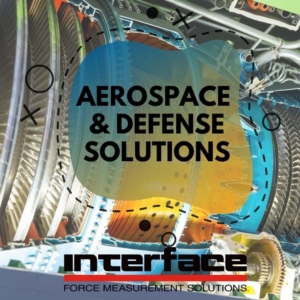Aerospace and Defense Industry Solutions
 Among the many applications Interface products are used for across multiple markets, there may be none that require the highest levels of accuracy, quality and reliability as does the aerospace and defense industry.
Among the many applications Interface products are used for across multiple markets, there may be none that require the highest levels of accuracy, quality and reliability as does the aerospace and defense industry.
By classification, aerospace largely comprises of those engaged in producing and servicing of commercial aircraft. The defense market is defined as those providing military weapons and systems designed to operate in the air, in the sea or on land.
The aerospace and defense industries are global markets that continue to expand their use of precision sensor technologies for advancing innovations in autonomous vehicles and flight systems, electric and hydrogen engines, as well additive manufacturing applications. Interface proudly serves the world’s largest manufacturers and suppliers in the aerospace industry by providing world-class force and torque measurement solutions for these types of requirements, as well as for their future inventions.
Over the past two years, the trends in the global commercial space ecosystem along with defense needs have created unique requirements that benefit from our five decades of being a premium provider for A&D equipment manufacturers and testing labs. We are able to meet these trending demands through our standard, engineered to order and completely custom force, torque and systems. These solutions are being utilized in testing of all types of vehicles, on the ground, in the water, and for flight.
A&D is a unique industry because of the complex needs of many applications. When we develop applications for other industries, we’re typically focused on solving a few specific challenges, whether it’s related to cost, safety, performance, environment, or other engineering specified design requirements. In aerospace and defense, every one of these factors needs to be addressed, as well as some special needs. Applications in the aerospace and defense industry cannot fail. If they do, it can put people, both military and civilians, in danger. That’s why force products in the defense industry need to be of the highest quality in all key factors.
Below are a few applications for force measurement in the defense industry. Each demonstrates the criticality of proper force testing, as well as the complexity of the projects Interface has been involved in.
SLS Tank Test
As outlined in NASA’s article on the SLS Tank Test, NASA’s goal was to push the very limits of a test version of the world’s largest rocket fuel tank. The project put incredible flight test strain on the tank to try and push it to its breaking point. After five hours of testing and more than 260% of the expected flight load, the tank finally buckled. Doing this helped engineers gather data on the tank to help intelligently optimize the final rocket ship.
In this application, load cells played the key role of collecting the flight force data. The extreme nature of the flight tests meant that the load cells needed to be incredibly durable and provide accurate data all the way through the breaking point.
Structural Testing
For the many hundreds of thousands of commercial and military vehicles on the market, especially those that fly, there are numerous force tests involved to validate a design and ensure they’re safe and of the highest quality to move into production. Load cells and torque transducers are used across a wide variety of vehicles for structural testing. The torque of the helicopter rotor is measured and validated using a torque transducer, or the wings and hull of an airplane are put through wind tunnels and other stress tests with load cells installed to collect data. All of these force applications are critical to ensuring that these vehicles can last beyond their intended breaking point and offer complete peace of mind to operators and passengers. There are a million different things that a military pilot is thinking about – the structural integrity of his or her aircraft should never be one of them.
Custom Sensors
Another area that has grown in recent years as technology pushes the aerospace and defense market forward is custom sensors. Test has gotten more sophisticated as the move to big data becomes more prevalent, and Interface has addressed this by working directly with customers to develop custom sensors that address unique challenges.
One of the biggest areas where we have seen a growing need for custom sensors is on test stands in thrust application. Test stands are often used in field testing on rocket or plane engines. In certain field applications, the test stand is outfitted with numerous load cells that must be custom designed with features like weatherization, multiple bridges, very-high precision, and more. The reason for this is because the cost of a thrust test in fuel alone can be incredibly high. You usually only get one shot at a successful thrust test. If there are any issues with the sensor, it’s going to be costly.
Interface has deep experience developing custom sensors for our aerospace and defense partners. We understand their needs and work closely with their engineering team to ensure they get it right the first time. If you’re interested in learning more about Interface and our solutions for the aerospace and defense industry, please visit us at www.interfaceforce.com/solutions/aerospace.
For additional references, check out our A&D related case studies and application notes:
Launching Into Orbit with Interface
Force Measurement for Space Travel
Interface’s Crucial Role in Vehicle and Urban Mobility Markets
Contributor: Elliot Speidell, Interface Regional Sales Director









